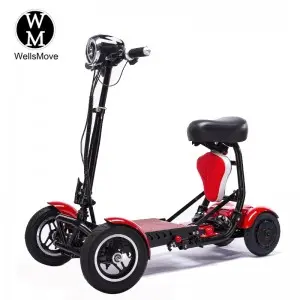The impact of controller waveform on the operation of electric scooters for the elderly: a key factor that cannot be ignored
Introduction
With the intensification of the global aging trend, the market demand for electric scooters for the elderly is growing. As a core component, its controller plays a vital role in vehicle performance and safety. The quality of the waveform output by the controller directly affects the operation of the motor. This article will explore in depth the specific impact of the unsatisfactory controller waveform on the operation of the motor of electric scooters for the elderly, aiming to attract the attention of relevant practitioners and users.
1. Basic concept of controller waveform
The controller waveform usually refers to the drive signal waveform output by the motor controller, and common ones are square waves, sine waves, trapezoidal waves, etc. In an ideal motor control system, the controller will generate a specific waveform signal to drive the power device of the motor according to the motor’s operating requirements and feedback information, and then control the motor’s speed, torque and other parameters.
2. Specific manifestations and effects of unsatisfactory waveforms
Too much high-order harmonic content
Influence: High-order harmonics will cause additional iron loss and copper loss in the motor, resulting in reduced motor efficiency and increased energy consumption. According to relevant research, when the high-order harmonic content in the waveform exceeds a certain proportion, the efficiency of the motor may drop by about 5%-10%. At the same time, high-order harmonics will also cause torque pulsation of the motor, causing the vehicle to shake and increase noise during driving, seriously affecting driving comfort.
Case: After using a certain brand of elderly scooters for a period of time, the owner reported that the vehicle had obvious vibration and abnormal noise when driving. After testing, it was found that there were a large number of high-order harmonics in the controller output waveform, resulting in unstable motor operation. After optimizing the controller and reducing the high-order harmonic content, the driving stability and noise level of the vehicle were significantly improved.
Waveform distortion
Impact: The distorted waveform will cause the current waveform of the motor to deviate from the ideal state, causing current distortion. This will cause the phase current of the motor to be unbalanced, which will cause uneven heating of the motor, accelerate the aging of the motor winding, and reduce the service life of the motor. Long-term current distortion may also cause faults such as short circuit of the motor winding, causing serious safety hazards.
Case: During the after-sales maintenance of a batch of electric scooters for the elderly, it was found that the motors of many vehicles had burned windings. After in-depth investigation, it was found that the waveform distortion of the controller caused abnormal motor current, which caused local overheating and eventually caused winding damage.
Abnormal PWM waveform
Impact: PWM (pulse width modulation) waveform is a key signal for the controller to control the speed and power of the motor. If the PWM waveform is not ideal, such as inaccurate pulse width, unstable frequency, etc., the speed control accuracy of the motor will decrease. The vehicle may have problems such as weak acceleration, slow deceleration or large speed fluctuations during driving, affecting the driving experience and safety.
Case: When starting and driving at low speed, the power output of a certain elderly scooter is obviously insufficient, and the speed is difficult to control stably. After testing, the PWM waveform of the controller is abnormal, causing the motor to fail to run at the expected speed. By adjusting the PWM parameters of the controller and optimizing the waveform quality, the power performance and speed stability of the vehicle have been effectively improved.
The rising and falling edges of the waveform are too slow
Impact: This will cause the transmission delay of the motor drive signal and affect the dynamic response speed of the motor. When the vehicle needs to accelerate or decelerate quickly, the motor cannot respond in time, increasing the braking distance and accident risk of the vehicle.
Case: In an emergency braking test of an elderly scooter, it was found that the braking distance of a certain vehicle was significantly longer than that of similar vehicles. After analysis, it was found that the rising and falling edges of the controller output waveform were too slow, so that the motor could not quickly reduce the speed after receiving the braking signal. After optimizing the controller and speeding up the rising and falling edges of the waveform, the braking performance of the vehicle was significantly improved.
3. The impact mechanism of unsatisfactory waveform on motor operation
Electromagnetic compatibility issues
The poor waveform output by the controller may cause electromagnetic interference to surrounding electronic equipment, including the control system of the motor itself. This interference will affect the normal operation of various sensors and signal processors in the motor drive circuit, resulting in inaccurate motor operation data collection, control signal transmission errors, and other problems, which will affect the stable operation of the motor.
Motor control algorithms are difficult to execute effectively
Most modern motor control systems use advanced control algorithms, such as vector control and direct torque control, which have certain requirements on the quality of the input waveform. If the controller waveform is not ideal, these control algorithms will not be able to accurately calculate the motor’s torque, speed, flux and other parameters, and thus cannot achieve precise control of the motor.
4. How to solve the problem of unsatisfactory controller waveform
Optimize controller hardware design
Use high-quality electronic components, such as high-performance microcontrollers, power devices and filter capacitors, to improve the stability and anti-interference ability of the controller. At the same time, reasonably design the circuit layout of the controller to reduce the impact of electromagnetic interference and ensure the quality of the output waveform.
Improve control algorithm
Use more advanced motor control algorithms, such as model-based predictive control, sliding mode variable structure control, etc. These algorithms are more adaptable to waveforms and can compensate for the impact of unsatisfactory waveforms to a certain extent, improving the control accuracy and dynamic performance of the motor.
Strengthen waveform monitoring and compensation
Add waveform monitoring function to the controller to detect the quality of the output waveform in real time. Once the waveform is found to be unsatisfactory, use compensation algorithms, such as harmonic compensation and waveform correction, to adjust and optimize the waveform to ensure that the motor can receive high-quality drive signals.
5. Summary
The controller waveform has a crucial impact on the operation of the motor of the electric scooter for the elderly. An unsatisfactory waveform will lead to a series of problems such as reduced motor efficiency, increased noise, and unstable driving, which seriously affect the performance and safety of the vehicle. Therefore, relevant companies and technicians should attach great importance to the quality of the controller waveform, continuously optimize the design and control strategy, and provide a more reliable electric drive system for the electric scooter for the elderly. At the same time, users should also pay attention to the operating status of the vehicle. If any abnormality is found, it should be inspected and repaired in time to ensure the safety and comfort of travel.
Post time: May-23-2025



